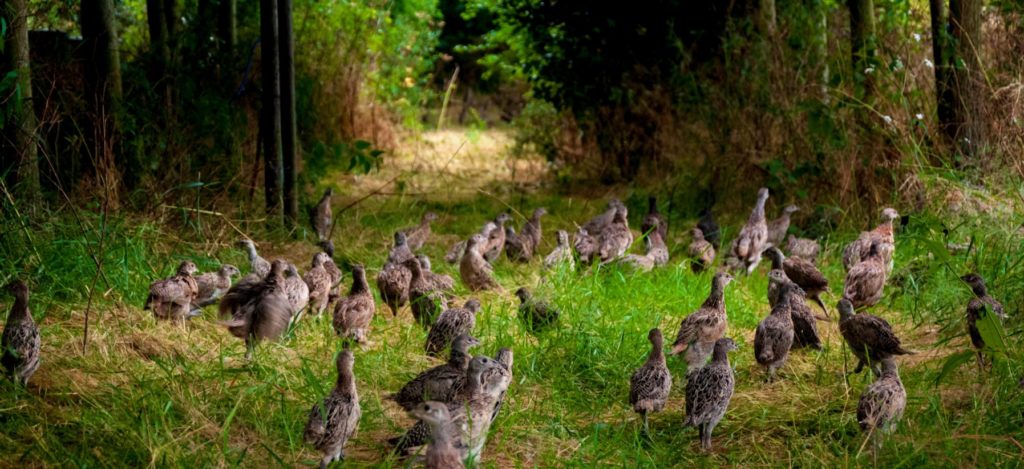How to respond to the DEFRA gamebird consultation

What the consultation is all about: Because of Wild Justice’s legal challenge settled in court last October DEFRA must take measures which will protect sites of nature conservation importance in England from the impacts of vast numbers of Pheasants and Red-legged Partridges released for recreational shooting. This consultation is necessary for DEFRA to regulate the release of non-native gamebirds so obviously we think it is important and we would encourage organisations and the general public to respond. You are entitled to respond wherever you live in the UK, and nudging DEFRA in the right direction should have implications for measures to be taken in Scotland, Wales and Northern Ireland.
Responding to a government consultation is not a bundle of laughs, and it may take around 40 minutes to get it done. Pro-shooting organisations are asking their supporters to send in responses, and we are sure that many of them will – it would be very helpful if you, as an individual, could make your views known too. What follows is our attempt to help you to do that. Wild Justice will make its own, more technical, response to the consultation.
Introduction to filling in the consultation: the DEFRA gamebird consultation can be found here – click here. You can fill the form online (click here) or print it out, fill it in and pop it in the post (click here). Hint: reading the pdf version first to get an overview and then filling in the online version is a good way to do it.
The structure of the consultation: there are some brief questions about yourself and then four main sections; Parts A – D. You don’t have to fill in each section. Indeed, Part D asks for feedback on the form where DEFRA is hoping you say that it was a bundle of laughs. You could safely ignore Part D or answer it in very few words. Part C asks you to suggest an alternative way forward to DEFRA’s proposals. You could safely ignore this section or answer it in very few words but we suggest that you do use that section and we suggest some points to make in it. Part B asks you to fill it in only if you are an interested party who releases gamebirds into the countryside. We’re pretty sure that most readers of this blog do not fall into that category so you can safely ignore Part B. So really it is Part A that forms the main consultation response and that is the longest section but it isn’t too scary once you have a good look at it. Below we take you through the consultation and the purple text indicates words that you might use in your response. At least they’ll give you some clues as to things that we think it is important to say.
Filling in your details – that’s easy
Completing Part A;
Q A1: No, and then fill in the text box along these lines DEFRA is proposing an interim licensing regime. That should start in the most precautionary way and then remove restrictions on the basis of evidence as time passes. DEFRA should not exclude the list of sites in Group 2 for four main reasons; precaution, clarity, error, futility. This licensing regime must protect SPAs and SACs (hereafter referred to as N2K sites) from damage. It is not precautionary to remove sites before they have been properly assessed. The clearest measure for users is to include all sites in these interim licensing measures and adjust the list over time when better knowledge is available. There are sites in this list which are both SPAs and SACs and yet it is unclear whether both sites are affected and there are overlaps between sites which are and aren’t mentioned in Group 2. There are sites in this list which are vulnerable to impacts of eutrophication and are proposed for exclusion in error. We accept that some of these sites will not be affected by gamebird releases because gamebirds won’t ever be released on or near them – excluding them is therefore futile. This list looks like a rushed and inadequate job. See my response to Part C.
Q A2: No, and then fill in the text box along these lines This very consultation states that most studies of gamebird movement have been restricted to 300m and so cannot have looked at issues at greater distances. Moreover, the Madden and Sage review quotes studies that show that both gamebird species travel further than 500m. Those studies are mostly limited to the shooting season. Moreover, the 500m buffer erroneously appears to be based only on known impacts of droppings and physical disturbance and ignores issues such as predation of reptiles and amphibians, increases in predator populations as a result of increased gamebird carrion etc. The GWCT’s Head of Advisory said on BBC Radio4 recently that ‘The majority of birds [Pheasants] don’t disperse more than a kilometre’ so a 500m Buffer Zone is clearly inadequate. You ask whether a 500m buffer zone will ensure that releases do not cause deterioration or significant disturbance of protected features of N2K sites and the answer is most definitely No as it is not based on science and is not precautionary. See my response to Part C.
Q A3: Yes and then fill in the text box along these lines But not sufficiently effective to meet the requirement of protecting N2K sites.
Q A4: No, and then fill in the text box along these lines This proposal allows releases to continue in undiminished numbers according to guidelines that are out of date (they were published in 2007) and where compliance is admitted by the shooting industry itself to be extremely poor (see https://www.sciencedirect.com/science/article/abs/pii/S0006320704003350?via%3Dihub ). These proposals do not limit the numbers of birds released, nor the number of release sites, nor their locations, only the densities of birds within release pens. These measures are totally inadequate and if implemented DEFRA will not be fulfilling its obligation to ensure that N2K sites are protected from damage. No gamebird releases should be allowed on N2K sites or in the Buffer Zone around them as the first step in licensing gamebird releases. See my response to Part C.
Q A5: Yes and then fill in the text box along these lines This is welcome and very important as a first step in effective regulation.
Q A6: Leave blank.
Q A7: I do not believe there should be any gamebird releases within the Buffer Zone. This is what is needed to protect N2K sites.
Q A8: I do not believe there should be any gamebird releases within the Buffer Zone. This is what is needed to protect N2K sites.
Q A9: Do not tick either Yes or No and then fill in the text box along these lines I agree with this and my representation is that this measure is essential and urgent.
Q A10: Do not tick either Yes or No but fill in the text box along these lines I agree with a sunset clause but I disagree that it should be after two years as this is too soon for the necessary research, analysis and consultation to be carried out. As far as I am aware DEFRA has not commissioned independent research or monitoring, nor provided Natural England with sufficient resources to carry out the necessary work. A period of at least five years is needed even if such resources are made available.
Completing Part B:
Q B1: if you are not a gamebird releaser then answer No and move on.
Completing Part C:
Q C1: Yes and then fill in the text box along these lines My proposal is that DEFRA scraps Group 2 sites, institutes a 1km Buffer Zone around all N2K sites and that no releases of Pheasants or Red-legged Partridges should be permitted for a 5 year period in that zone or on any N2K sites. That is a precautionary, clear and effective interim arrangement that protects nature. If appropriate, these modest restrictions can be loosened on the basis of good evidence in future.
I would like to make some further points.
a. I do not consider this consultation to have been properly conducted as it lasts only three weeks, was delayed and DEFRA has imposed ludicrously short word limits on answering complex questions.
b. DEFRA appears to have written the consultation with measures that the recreational shooting industry would want rather than ones which ensure protection of N2K sites of conservation importance.
c. This consultation clings to the myth of 500m being an adequate Buffer Zone despite DEFRA being well aware that there is little scientific evidence to support this (see here https://markavery.info/2020/11/05/gamebirds-victory-16-the-500m-myth/ ) and so this consultation is knowingly misleading. And in any case, the measures proposed to apply to the Buffer Zone are nugatory.
d. Part B does not in any way properly address economic impacts, which in any case must be subservient to the need to protect N2K sites from damage. Since the measures do not limit overall release numbers, and hardly limit current practice, there can be no overall economic impact. The consultation simply invites unverifiable moans about impacts from the very industry that needs to be regulated in order to protect the environment. At most, any restrictions on release numbers locally can create opportunities for releases in less sensitive sites and so others, who are not invited to comment, will benefit. At this stage it is unclear whether, or to what extent, recreational shooting will be possible in any case in the 2021/22 shooting season because of COVID-19 restrictions. Further, there are economic impacts of gamebird releases on the general public which are completely ignored in this consultation.
Completing Part D: voluntary.
That’s it!
Remember, the deadline is Monday. The more responses DEFRA gets the better. We’d be delighted to hear that you have responded – send us an email if you like. We hope this advice helps but you should make any points you wish and in any way you wish. If you have questions or queries about filling in the consulation then we may be able to help – email us at admin@wildjustice.org.uk and give your email the title GAMEBIRDS and we will try to help but we cannot promise that we’ll be able to answer long or complex questions very quickly – we’ll do our best.
